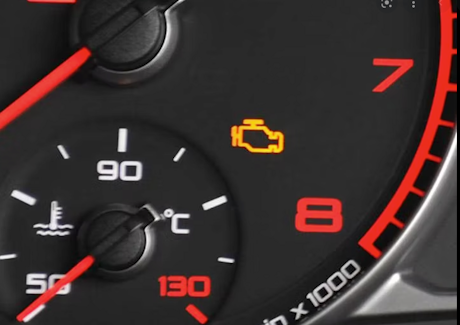What does the engine management light mean?
June 03, 2025 by David Motton

If the engine management light illuminates on your dashboard, you may be wondering what it means and what to do next. This straightforward guide will explain what an engine management light is and what to do if you see the light on your dashboard.
What is the engine management light?
An engine management light, or EML (sometimes also called the ‘check engine light’) is a dashboard warning light that illuminates when an issue with your car’s engine, exhaust or emissions system has cropped up. The EML will not alert you to a specific issue as a ‘low coolant’ or ‘check oil level’ message would, instead being a general warning that there is something wrong with your car.

Modern cars are very complicated and high-tech. They use multiple on-board sensors to monitor how the engine and other systems are performing. By measuring things like the amount of air being drawn into the system, the type of emissions being produced, how well the engine is igniting the fuel, a car’s on-board computers can tell how well the vehicle is running.
Most of the time these sensors detect nothing out of the ordinary. But when something goes wrong – either slightly or seriously – the EML can illuminate to alert you. The EML is represented by a universal symbol in the shape of an engine outline, while each car can show an amber, red or flashing EML, with each indicating a certain severity of problem.
Remember, you can buy a brand new or used car right here on Carwow. And you can also sell your car, too. We’re here to help you through every step of your car-changing journey.
What do the different engine management lights mean?
Engine management lights illuminate in different colours, and are sometimes solid, sometimes flashing. It’s important to know the difference between the different types of EML.
Amber engine management light
An orange or amber light is the least serious. If this light comes on and stays on, it means that you should be able to keep driving as normal but take your car to be looked at by a garage as soon as you can.
Flashing engine management light
A flashing orange light means that there is a problem that could affect how the car drives or handles, such as an engine misfire. You might be able to feel your car shake, or the engine could suddenly sound different. If this light comes on, you should take your car to be inspected immediately.
Red engine management light
A red engine management light means that there is a very serious problem. If you see this, you should stop at the nearest safe place and call your breakdown provider straight away.
What can cause the engine management light to come on?
All sorts of problems can cause an engine management light to come on. These are some of the most common…
1. Oxygen sensors/mass airflow sensor
Oxygen sensors measure how much unburnt oxygen passes through the exhaust. This shows whether an engine is burning too little or too much fuel and, if the sensors find a problem, they can set off the engine management light. Mass airflow sensors (MAF), meanwhile, measure the fuel/air mixture in an engine, and if they detect this blend is not right, or if the MAF develops a fault itself, the EML light can appear.
2. Ignition system fault
If you’re in a petrol car, problems with your spark plugs can set off your engine warning light. Replacing one or more spark plugs should fix this issue, although the problem may be to do with something else, including coil packs, which control the spark plugs.

3. Loose fuel cap
If your fuel filler cap is loose or missing, it can set off your engine management light. This is because a loose cap can cause vapour loss, where fuel evaporates and subsequently escapes from the car. This reduces fuel efficiency and can also be a safety risk.
Luckily, a loose fuel cap is an easy fix. Just reattach it properly and the engine management light should turn off after you’ve been on the road for a short while.
4. Blocked fuel pump
Over time, it’s easy for a fuel pump to become clogged or dirty, to the point where it doesn’t do its job properly. This is a serious issue, with the potential to not only turn the engine management light on, but also briefly cut the engine when you’re driving at high speeds. It should be a straightforward fix for a professional mechanic.
5. Damaged catalytic converter
The catalytic converter is responsible for reducing harmful emissions made by your car. It transforms toxic carbon monoxide and nitrogen oxide gases into a mix of CO2, nitrogen and water. Problems like unburned fuel leaking and/or a leaky exhaust valve can damage or even break your catalytic converter, which will subsequently activate your engine management light.
A damaged catalytic converter is a major problem, proving environmentally unsafe and potentially expensive. If this happens, take your car to be serviced as soon as you can.
6. Blocked diesel particulate filter
A diesel particulate filter (DPF) is fitted to modern diesel-powered cars to trap soot from the exhaust and reduce your emissions. DPFs need to clean, or ‘regenerate’ themselves periodically, and this tends to occur when the car is driven at higher speeds (above 40mph or so) for a reasonable length of time.
If the DPF doesn’t regenerate when it needs to, it can become blocked and subsequently cause your engine management light to turn on. You may be able to get the DPF to regenerate by driving at a higher speed (where limits allow) or by maintaining high engine revs, but in other cases the DPF may need the attention of a mechanic. Cars with a DPF tend to have a dedicated warning light to indicate the filter is blocked, but the EML light is likely to appear as well. Our guide to DPFs has more details.
How to reset the engine management light
As sophisticated as they may be, modern cars can develop glitches, and it’s possible turning the engine on and off may be enough for the EML to disappear.
This won’t be the case if the light is warning of a serious fault. Even if the EML disappears on startup, it may reappear as you drive on.
If the cause of the issue was simple (for example, a loose fuel cap) then putting this right and restarting the car may resolve issues, either immediately or after a short while of driving.
If the light doesn’t go out after you’ve fixed the issue you will need to have it reset, and this will require plugging in an OBD (on-board diagnostics) tool at a dealer or garage. Having a professional look over the car is probably a good idea anyway, as the technician will use the OBD tool to scan for any error codes that might be present – it’s possible for more than one thing to go wrong at a time, after all.
You could consider disconnecting the negative lead from the car’s battery to reset the EML, but this can cause other issues to appear, so only try this if you’re confident in what you’re doing.
Is an engine management light an MOT failure?
If your engine management light comes or remains on during an MOT, then it is classed as a major fault. After all, if the light is on, there’s a very good chance your car is either unsafe or not working as well as it should be.
Long story short: an illuminated engine management light is an instant MOT fail.
Engine management light FAQs
How do I turn off an engine management light?
Try turning the car on and off. If there’s nothing more than a glitch in the system this may be enough for the light to disappear. Just be aware that the light may turn on again after a few miles.
If that doesn’t do the trick, book the car in at a garage so a professional can take a look. Once they have solved the problem which the EML is warning you about, the light should turn off.
Can I drive my car with the engine management light on?
That depends on the colour of the warning light. Amber is the least serious. You shouldn’t ignore it but it’s okay to keep driving until a garage can fit you in.
A flashing orange light is more serious. Get the car to a garage ASAP, although you should be okay to drive it there.
If the light is red you need to stop and call your breakdown provider. Driving with a red light on could cause expensive damage and may be dangerous.
Why does my engine light come on and I lose power?
The car will have gone into a ‘limp home mode’ to protect the engine. You’ll be able to drive, but only at a reduced speed to prevent damage to engine components.
See also:
What is anti-freeze?
What to do if you break down on the motorway
Car Change? Carwow!
Looking for a new set of wheels? With Carwow you can sell your car quickly and for a fair price – as well as find great offers on your next one. Whether you’re looking to buy a car brand new, are after something used or you want to explore car leasing options, Carwow is your one stop shop for new car deals.















